Akee

A tropical plant. It is native to tropical West Africa. It suits the humid tropical lowlands. It grows up to 900 m above sea level. It needs 2,000 mm of rain per year. It does best in moist, well composted soils in a sheltered, sunny position. It is drought and frost tender. It can grow in the subtropics and survive with temperatures near freezing. It suits hardiness zones 10-12.
Also known as:
Abai, Achee, Akee Apple, Aki, Akie, Akye, Akyen, Arbol de seso, Bien me sabe, Castanha, Direbu, Finza, Finzan, Fisa, Huevo vegetal, Ishin, Ishin jije, Itchin, Kaka, Lissetin, Merey del diablo, Moufodoom, Okpu, Otousi, Palo de seso, Pan y quesito, Peeryu, Pera roja, Seso vegetal, Vegetable brain
Synonyms
- Cuprona edulis
- Cupania sapida J. Voigt
Edible Portion
- Fruit, Aril, Flowers - flavour, Caution, Leaves
Where does Akee grow?
Found in: Africa, Asia, Australia, Benin, Brazil, Burkina Faso, Cameroon, Caribbean, Central Africa, Central African Republic, CAR, Central America, Colombia, Cook Islands, Costa Rica, Côte d'Ivoire, Cuba, Dominican Republic, Gabon, Ghana, Guatemala, Guianas, Guinea, Guinée, Guinea-Bissau, Guyana, Haiti, Hawaii, India, Indonesia, Ivory Coast, Jamaica, Mali, Martinique, Mexico, Nigeria, North America, Pacific, Panama, Papua New Guinea, PNG, Philippines, Pohnpei, Sao Tome and Principe, SE Asia, Senegal, Sierra Leone, Singapore, South America, St Lucia, Sudan, Suriname, Trinidad, Togo, United States, Venezuela, West Africa, West Indies
Notes: There are 4 Blighia species. It is a good source of beta-carotene and Vitamin C. Hypoglycin-A was isolated for the first time from the 'edible' aril of Blighia sapida (Ackee tree) and subsequently traced as the cause of an intoxication known as 'Jamaica vomiting sickness".
Status: In Papua New Guinea it is an introduced crop not widely grown and rarely used. The fruit is popular in Jamaica. It is part of their national dish. It is a commonly used food in West Africa.
Growing Akee
Cultivation: Trees can be grown by seeds or cuttings. They can also be grafted.
Edible Uses: The fleshy white aril around the seeds is edible after the fruit opens naturally. It is often cooked by boiling in salt water. It looks like scrambled eggs after cooking. CAUTION The seeds are poisonous. The unripe aril is inedible. The pink tissue between the aril and seed is poisonous. The aril must be fully ripe before eating. It is light on the open jacket that destroys the poison. The flowers are used in the preparation of aromatic water. The young leaves are cooked and eaten.
Production: In warm climates it grows quickly. It often bears two crops per year. It starts to produce after 4 years. Trees can keep producing for 50 years. Fruit matures in about 90 days.
Nutrition Info
per 100g edible portion| Edible Part | Energy (kcal) | Protein (g) | Iron (mg) | Vitamin A (ug) | Vitamin c (mg) | Zinc (mg) | % Water |
|---|---|---|---|---|---|---|---|
| Fruit aril | 180 | 8.75 | 5.5 | 0 | 78 | - | 57.6 |
Akee Photos

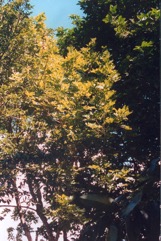
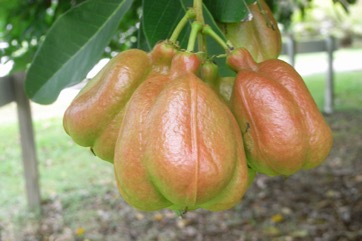
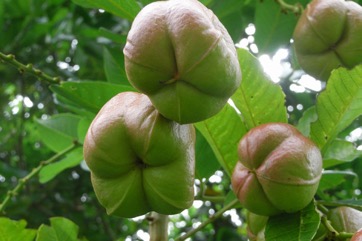
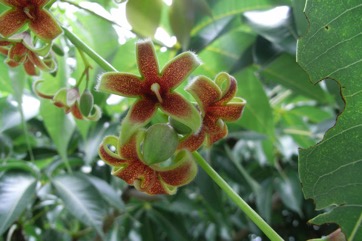
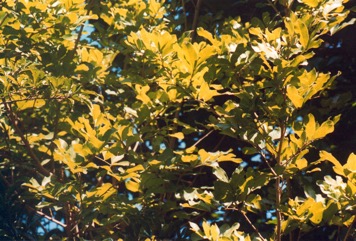
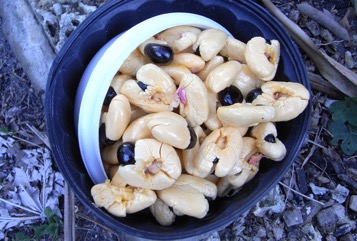
References
Achigan-Dako, E, et al (Eds), 2009, Catalogue of Traditional Vegetables in Benin. International Foundation for Science.
Ambasta S.P. (Ed.), 2000, The Useful Plants of India. CSIR India. p 75
Ambe, G., 2001, Les fruits sauvages comestibles des savanes guinéennes de Côte-d’Ivoire : état de la connaissance par une population locale, les Malinké. Biotechnol. Agron. Soc. Environ. 5(1), 43-48
Aniama, S. O., et al, 2016, Ethnobotanical documentaton of some plants among Igala people of Kogi State (Nigeria). The International Journal Of Engineering And Science (IJES). 5(4) pp 33-42
Ann. Bot. (Koenig & Sims) 2:571, t. 16-17. 1806
Assogbadjo, A. E. et al, 2013, Specific Richness and Cultural Importance of Wild Edible Trees in Benin. Acta Hort. 979, ISHS 2013
Atato, A., et al, 2010, Diversity of Edible Wild Fruit Tree Species of Togo. Global Science Books.
Awodoyin, R.O., Olubode, O.S., Ogbu, J.U., Balogun, R.B., Nwawuisi, J.U. and Orji, K.O., 2015, Indigenous Fruit Trees of Tropical Africa: Status, Opportunity for Development and Biodiversity Management. Agricultural Sciences, 6, 31-41
Barwick, M., 2004, Tropical and Subtropical Trees. A Worldwide Encyclopedic Guide. Thames and Hudson p 53
Bodkin, F., 1991, Encyclopedia Botanica. Cornstalk publishing, p 152
Boedecker, J., et al, 2014, Dietary contribution of Wild Edible Plants to women’s diets in the buffer zone around the Lama forest, Benin – an underutilized potential. Food Sec. 6:833–849
Brouk, B., 1975, Plants Consumed by Man. Academic Press, London. p 151
Burkill, H. M., 1985, The useful plants of west tropical Africa, Vol. 3. Kew.
Burkill, I.H., 1966, A Dictionary of the Economic Products of the Malay Peninsula. Ministry of Agriculture and Cooperatives, Kuala Lumpur, Malaysia. Vol 1 (A-H) p 336
Busson, 1965,
Catarino, L., et al, 2008, An annotated checklist of the vascular flora of Guinea-Bissau (West Africa). Blumea 53:1-222 p 108
Catarino, L., et al, 2016, Ecological data in support of an analysis of Guinea-Bissau's medicinal flora. Data in Brief 7 (2016):1078-1097
Chandrashekara, U. M., 2009, Tree species yielding edible fruit in the coffee-based homegardens of Kerala, India: their diversity, uses and management. Food Sec. 1:361-370
Codjia, J. T. C., et al, 2003, Diversity and local valorisation of vegetal edible products in Benin. Cahiers Agricultures 12:1-12
Dalziel, J. M., 1937, The Useful plants of west tropical Africa. Crown Agents for the Colonies London.
Dansi, A., et al, 2008, Traditional leafy vegetables and their use in the Benin Republic. Genet Resour Crop Evol (2008) 55:1239–1256
Dansi, A., et al, 2012, Diversity of the Neglected and Underutilized Crop Species of Importance in Benin. The Scientific World Journal. Volume 2012, Article ID 932947, 19 pages
Darley, J.J., 1993, Know and Enjoy Tropical Fruit. P & S Publishers. p
de Polle, E., Plantas Silvestres Comestible de Guatemala. 1(1) Universidad de San Carlos de Guatemala.
Ekue, M. RM., 2010, Uses, traditional management, perception of variation and preferences in ackee (Blighia sapida K. D. Koenig) fruit traits in Benin: implications for domestication and conservation. Journal of Ethnobiology and Ethnomedicine, 6:12
Facciola, S., 1998, Cornucopia 2: a Source Book of Edible Plants. Kampong Publications, p 224
French, B.R., 1986, Food Plants of Papua New Guinea, A Compendium. Asia Pacific Science Foundation p 297
Hedrick, U.P., 1919, (Ed.), Sturtevant's edible plants of the world. p 108
Hibbert, M., 2002, The Aussie Plant Finder 2002, Florilegium. p 44
INFOODS:FAO/INFOODS Databases (As Bilphia sapida)
Jardin, C., 1970, List of Foods Used In Africa, FAO Nutrition Information Document Series No 2.p 123
John, L., & Stevenson, V., 1979, The Complete Book of Fruit. Angus & Robertson p 47
Keay, R.W.J., 1989, Trees of Nigeria. Clarendon Press, Oxford. p 358
Little, E. L., et al, 1974, Trees of Puerto Rico and the Virgin Islands. USDA Handbook 449. Forestry Service. p 486
Llamas, K.A., 2003, Tropical Flowering Plants. Timber Press. p 341
Lorenzi, H., Bacher, L., Lacerda, M. & Sartori, S., 2006, Brazilian Fruits & Cultivated Exotics. Sao Paulo, Instituto Plantarum de Estuados da Flora Ltda. p 606
Macmillan, H.F. (Revised Barlow, H.S., et al) 1991, Tropical Planting and Gardening. Sixth edition. Malayan Nature Society. Kuala Lumpur. p 295
Martin, F. W., et al, 1987, Perennial Edible Fruits of the Tropics. USDA Handbook 642 p 56
Omawale, 1973, Guyana's edible plants. Guyana University, Georgetown p 2
Morton, J. F., 1987, Fruits of Warm Climates. Wipf & Stock Publishers p 269
Menninger, E.A., 1977, Edible Nuts of the World. Horticultural Books. Florida p 69
Miguel, E., et al, 1989, A checklist of the cultivated plants of Cuba. Kulturpflanze 37. 1989, 211-357
N'Danikou, S. et al, 2010, Eliciting Local Values of Wild Edible Plants in Southern Bénin to Identify Priority Species for Conservation. Economic Botany, 20(10), 2011, pp. 1–15.
Perry, F., and Hay, R., 1982, Guide to Tropical and Subtropical Plants. Sun Books p 14
Peters, C. R., O'Brien, E. M., and Drummond, R.B., 1992, Edible Wild plants of Sub-saharan Africa. Kew. p 180
Plants of Haiti Smithsonian Institute http://botany.si.edu/antilles/West Indies
Purseglove, J.W., 1968, Tropical Crops Dicotyledons, Longmans. p 642
Segnon, A. C. & Achigan-Dako, E. G., 2014, Comparative analysis of diversity and utilization of edible plants in arid and semi-arid areas in Benin. Journal of Ethnobiology and Ethnomedicine 2014, 10:80
Segura, S., et al, 2018, The edible fruit species in Mexico. Genet Resour Crop Evol (2018) 65:1767–1793
Smith, P.M., 1979, Akee, in Simmonds, N.W., (ed), Crop Plant Evolution. Longmans. London. p 320
Staples, G.W. and Herbst, D.R., 2005, A tropical Garden Flora. Bishop Museum Press, Honolulu, Hawaii. p 517
Sukarya, D. G., (Ed.) 2013, 3,500 Plant Species of the Botanic Gardens of Indonesia. LIPI p 157
Tankard, G., 1990, Tropical fruit. An Australian Guide to Growing and using exotic fruit. Viking p 104
Terra, G.J.A., 1973, Tropical Vegetables. Communication 54e Royal Tropical Institute, Amsterdam, p 29
USDA, ARS, National Genetic Resources Program. Germplasm Resources Information Network - (GRIN). [Online Database] National Germplasm Resources Laboratory, Beltsville, Maryland. Available: www.ars-grin.gov/cgi-bin/npgs/html/econ.pl (10 April 2000)
van Wyk, B., 2005, Food Plants of the World. An illustrated guide. Timber press. p 91
Vivien, J. & Faure, J.J., 1985, Abres des forets dense d'Afrique Centrale. Agence de Cooperation Culturelle et Technique. Paris. p 400
Vivien, J., & Faure, J.J., 1996, Fruitiers Sauvages d'Afrique. Especes du Cameroun. CTA p 304
Wickens, G.E., 1995, Edible Nuts. FAO Non-wood forest products. FAO, Rome. p150
Williams, C.N., Chew, W.Y., and Rajartnam, J.A., 1989, Tree and Field Crops of the Wetter Regions of the Tropics. Longman, p 116
World Checklist of Useful Plant Species 2020. Royal Botanic Gardens, Kew
www.worldagroforestrycentre.org/treedb/
Zuchowski W., 2007, Tropical Plants of Costa Rica. A Zona Tropical Publication, Comstock Publishing. p 201